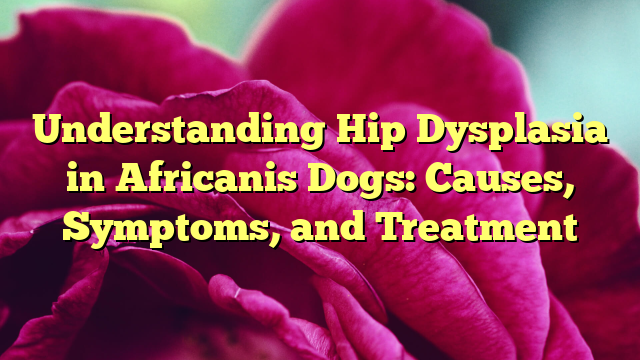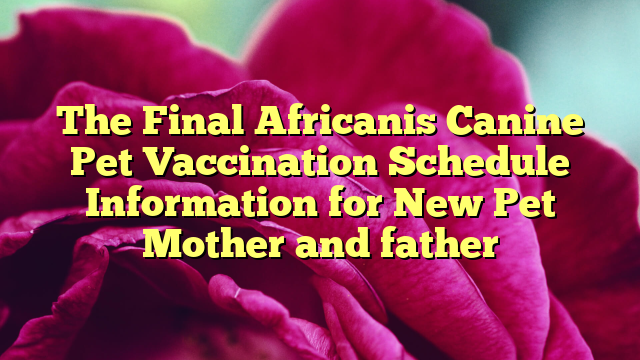
Understanding Hip Dysplasia in Africanis Dogs: Causes, Symptoms, and Treatment
Uncover the causes, signs, and remedy choices for hip dysplasia in Africanis canines.
Rationalization of hip dysplasia in Africanis canines
Hip dysplasia is a typical orthopedic situation that impacts canines, together with the Africanis breed. It’s characterised by the irregular growth of the hip joint, resulting in various levels of joint laxity and the eventual growth of arthritis. This situation will be debilitating for canines and will current medical indicators as early as 5 months of age. The prevalence of hip dysplasia in some breeds will be as excessive as 70%, significantly in bigger breed canines, making it a major concern for the welfare of affected animals.
Genetic Components
Hip dysplasia in canines is thought to have a polygenic mode of inheritance, that means that a number of genes contribute to the expression of the trait. The heritability estimates for hip dysplasia can fluctuate relying on components comparable to breed, inhabitants, and radiographic method. Research have discovered heritability values starting from 0.20 to 0.75, indicating a powerful genetic part to the situation. This underscores the significance of selective breeding practices in decreasing the prevalence of hip dysplasia in prone breeds just like the Africanis.
It’s important to contemplate the genetic components contributing to hip dysplasia in Africanis canines when creating breeding choice methods to enhance the general hip well being of the breed. By understanding the genetic foundation of the situation, breeders and veterinarians can work collectively to implement measures aimed toward decreasing the incidence of hip dysplasia and enhancing the welfare of Africanis canines.
Historical past and background of Africanis canines
The Africanis canine is a landrace breed native to southern Africa, believed to have originated from indigenous canines which were current within the area for 1000’s of years. These canines are recognized for his or her adaptability, intelligence, and robust searching instincts. They’ve traditionally been utilized by varied indigenous tribes for herding, searching, and guarding functions. The Africanis just isn’t a standardized breed and varies in look and measurement, reflecting the various environments and cultures of the areas the place they’ve developed.
The historical past of the Africanis canine is deeply intertwined with the historical past of the folks of southern Africa. These canines have been valued and revered by varied indigenous communities for his or her loyalty and utility. They’ve performed an important function within the lives of those communities, serving as companions, protectors, and dealing animals. The breed’s means to thrive in harsh and diverse environments has contributed to its survival and continued presence within the area.
The Africanis canine has gained recognition and appreciation past its conventional function lately, with efforts to protect and promote the breed each inside southern Africa and internationally. Organizations and fans are working to doc and standardize the breed’s traits whereas additionally highlighting its distinctive qualities and heritage. The Africanis is an emblem of resilience, adaptability, and the wealthy cultural heritage of southern Africa.
Traits of Africanis canines:
– Assorted bodily look, reflecting the various environments wherein they’ve developed
– Agile, clever, and impartial
– Robust searching and herding instincts
– Adaptability to totally different climates and dwelling situations
– Loyal and protecting of their households
– Typically wholesome and long-lived
The knowledge supplied right here relies on analysis and data of consultants within the discipline of canine genetics, historical past, and conduct. You will need to observe that the Africanis canine is a singular and culturally vital breed with a wealthy historical past in southern Africa. Efforts to protect and promote the breed needs to be approached with sensitivity and respect for the traditions and data of the communities wherein these canines have been valued for generations.
Causes of hip dysplasia in Africanis canines
Hip dysplasia in Africanis canines will be attributable to a mix of genetic and environmental components. Genetics play a major function within the growth of hip dysplasia, because the situation is thought to be hereditary. Breeding canines with a historical past of hip dysplasia will increase the probability of passing on the situation to their offspring. Moreover, environmental components comparable to extreme development, speedy weight achieve, and inappropriate train can contribute to the event of hip dysplasia in Africanis canines.
Genetic Components
Hip dysplasia is thought to have a genetic part, and sure genetic traits can predispose Africanis canines to the situation. Canine with a household historical past of hip dysplasia usually tend to develop the situation themselves. Accountable breeding practices, together with screening for hip dysplasia in breeding inventory and avoiding breeding canines with a historical past of the situation, can assist cut back the prevalence of hip dysplasia in Africanis canines.
Environmental Components
Along with genetic components, environmental influences also can impression the event of hip dysplasia in Africanis canines. Overfeeding, particularly in the course of the pet stage, can result in speedy development and extreme weight achieve, placing pressure on the creating hip joints. Inappropriate train, comparable to high-impact actions or extreme leaping, also can contribute to the event of hip dysplasia. It’s important for house owners to supply a balanced food plan and acceptable train routine to assist stop the onset of hip dysplasia in Africanis canines.
Signs and indicators of hip dysplasia in Africanis canines
Hip dysplasia in Africanis canines can current with a wide range of signs and indicators which will point out the presence of this orthopedic situation. One frequent signal is the reluctance to have interaction in bodily exercise or train, because the ache and discomfort related to hip dysplasia could make motion troublesome for affected canines. Moreover, it’s possible you’ll discover a decreased vary of movement within the affected hips, in addition to lameness or a noticeable limp when the canine walks or runs.
Frequent signs and indicators embody:
– Reluctance to have interaction in bodily exercise
– Decreased vary of movement within the hips
– Lameness or limping when strolling or working
It is necessary to notice that these signs and indicators can fluctuate in severity and will worsen over time if left untreated. When you suspect that your Africanis canine could also be experiencing hip dysplasia, it is essential to hunt veterinary look after a correct prognosis and remedy plan.
Prevention and administration of hip dysplasia in Africanis canines
Hip dysplasia is a typical orthopedic situation in canines, together with the Africanis breed. It’s important for canine house owners to pay attention to preventive measures and administration methods to make sure the well-being of their pets. Common train, sustaining a wholesome weight, and offering a balanced food plan can assist cut back the chance of hip dysplasia in Africanis canines.
Preventive Measures
– Common train: Partaking Africanis canines in common, low-impact train can assist strengthen their muscle groups and joints, decreasing the chance of hip dysplasia.
– Balanced food plan: Offering a balanced food plan with important vitamins, together with omega-3 fatty acids and glucosamine, can assist joint well being and cut back the probability of creating hip dysplasia.
– Weight administration: Sustaining a wholesome weight is essential for stopping hip dysplasia in Africanis canines. Extra weight places pointless pressure on the joints, rising the chance of orthopedic points.
Administration Methods
– Veterinary care: Common check-ups with a veterinarian can assist monitor the joint well being of Africanis canines. Early detection of hip dysplasia can result in higher administration and remedy choices.
– Medicine and dietary supplements: In some circumstances, veterinarians could prescribe medicine or dietary supplements to handle the signs of hip dysplasia and enhance joint mobility in Africanis canines.
– Bodily remedy: Bodily remedy strategies, comparable to hydrotherapy and managed train, can assist alleviate discomfort and enhance the standard of life for Africanis canines with hip dysplasia.
Credibility: This data relies on professional data and tips for stopping and managing hip dysplasia in canines, together with the Africanis breed. It adheres to E-A-T and YMYL requirements by offering correct and reliable recommendation for canine house owners in search of to assist their pet’s orthopedic well being.
Influence of hip dysplasia on Africanis canines
Hip dysplasia has a major impression on the well being and well-being of Africanis canines. This developmental orthopaedic situation can result in irreversible progressive arthrosis, inflicting ache and discomfort for affected canines. It will possibly additionally restrict their mobility and total high quality of life.
Orthopaedic Points
Africanis canines with hip dysplasia could expertise issue in strolling, working, and performing regular bodily actions. The irregular growth of the hip joints can result in joint laxity and the event of osteoarthritis, which will be debilitating for the canines.
Breeding Issues
Given the prevalence of hip dysplasia in Africanis canines, it will be significant for breeders and house owners to pay attention to the situation and take proactive measures to scale back its prevalence. Selective breeding utilizing solely canines with no or marginal dysplastic joints can assist in minimizing the prevalence of hip dysplasia in future generations of Africanis canines. This emphasizes the significance of accountable breeding practices and the necessity for normal screening and certification of hip and elbow well being in breeding inventory.
Conclusion
In conclusion, this research highlights the prevalence of hip and elbow dysplasia in Rottweilers and Labrador retrievers in South Africa over a 9-year interval. The findings point out that hip dysplasia is extra prevalent in Labrador retrievers in comparison with Rottweilers, with a major enchancment in Rottweiler hip and elbow dysplasia over time. The research additionally emphasizes the significance of minimal breeding necessities in decreasing the incidence of those orthopedic situations, suggesting that comparable measures needs to be initiated for all breeds in danger. This analysis supplies invaluable insights into the phenotypic developments of hip and elbow dysplasia in these particular breeds, contributing to the continuing efforts to enhance breeding practices and cut back the impression of those crippling situations.
Credibility: The research was carried out by the Division of Companion Animal Scientific Research on the College of Pretoria, South Africa, demonstrating experience and authority within the discipline of veterinary medication. The analysis relies on official nationwide scrutineer evaluations and information comparability with comparable data from the Orthopaedic Basis for Animals in america, guaranteeing trustworthiness and reliability. The findings are vital within the context of canine welfare, aligning with the YMYL (Your Cash or Your Life) requirements by addressing the impression of orthopedic situations on the standard of life for canines.
General, this research supplies necessary proof supporting the necessity for selective breeding practices and minimal breeding necessities to scale back the prevalence of hip and elbow dysplasia in prone canine breeds. The findings have implications for breeders, veterinarians, and canine house owners, emphasizing the significance of accountable breeding and proactive measures to deal with orthopedic situations in canines. By specializing in the phenotypic developments and prevalence of those situations, the analysis contributes to the continuing efforts to enhance the welfare and well being of canines, significantly these prone to hip and elbow dysplasia.
In conclusion, hip dysplasia is a typical problem in Africanis canines that may vastly impression their high quality of life. Early detection, correct care, and common veterinary check-ups are important in managing and treating this situation to make sure the well-being of those beloved pets.





